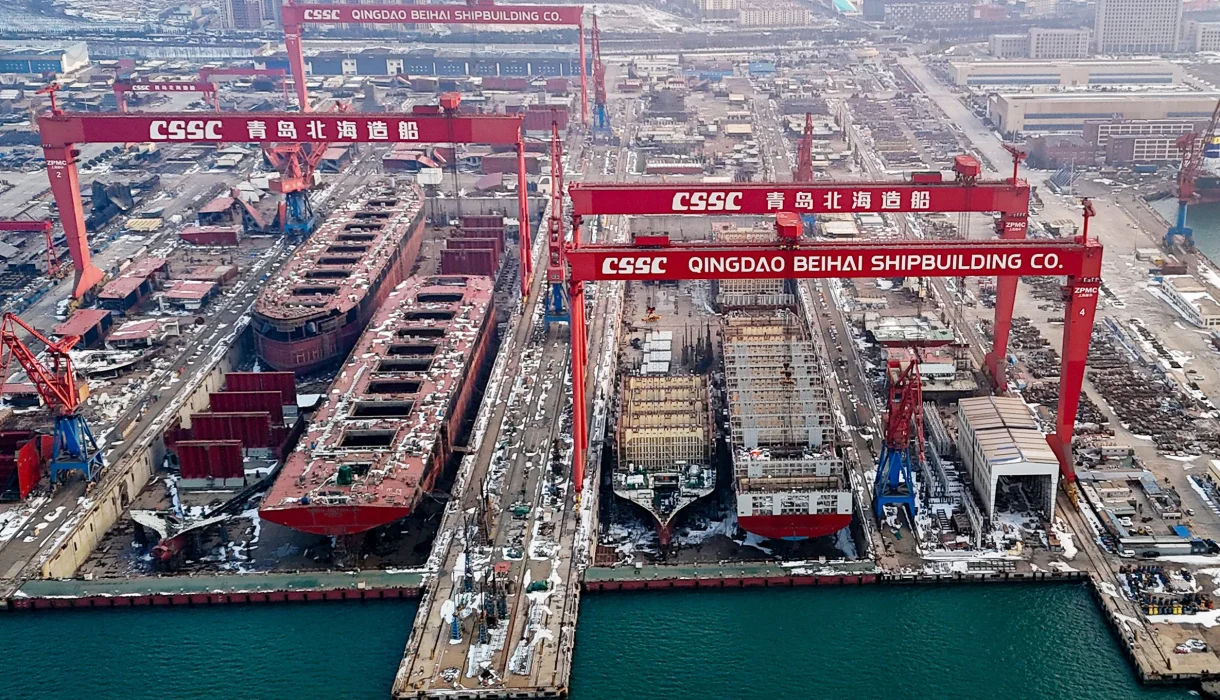
Naval Construction: How China Outpaces the US Industry
Posted in :
China now builds over half of the world’s ships, while U.S. shipbuilding has declined to a historic low. This blog explores the economic, historical, and geopolitical reasons behind this shift—and what the U.S. must do to regain maritime independence and national security.
The current state of the naval construction industry, highlighting China’s dominance and the implications for the US market. It explores historical perspectives, economic influences, and trade policies, providing insights into future developments in the maritime sector.
Imagine a world where your couch, bicycle, or even that shiny new car took a journey across the ocean on a ship constructed in another country. For many, this is a reality. As I once watched a massive cargo ship glide into the harbor, I was struck by the thought of how much our economy relies on naval construction—particularly the intricate operations that unfold behind the scenes in places like China, which now accounts for over half of the global shipbuilding industry. But what does this mean for the US, a nation that once led the industry?
The Rise of Chinese Dominance in Shipbuilding
China’s shipbuilding industry has undergone a remarkable transformation. Today, over 50% of global ships are built in China. This is a staggering increase from less than 5% in 1999. How did this happen? The answer lies in a combination of strategic government policies, investment in infrastructure, and a booming economy.
Key Statistics
- China controls about 95% of global container production.
- As of 2023, 34% of vessels currently in operation were built in China.
- From 2020 to 2022, China produced more than 4,000 new ships.
China’s entry into the World Trade Organization (WTO) was a pivotal moment. It opened doors for international trade and investment. This shift allowed China to ramp up its shipbuilding capabilities significantly. With government support, the industry flourished. Investment in modern shipyards and technology has made Chinese shipbuilding more efficient and cost-effective.
Historical Context
Historically, the United States led the world in shipbuilding. During World War II, American shipyards produced thousands of vessels. However, the landscape has changed dramatically. Countries like Japan and South Korea initially took the lead, but China has now emerged as the dominant force.
Today, a single Chinese shipyard can produce more vessels in a year than all American shipyards combined. This shift has profound implications for global shipping dynamics. As one expert noted,
“China is not just a leader; they’re redefining what it means to build at scale.”
Challenges for the U.S.
The U.S. faces significant challenges in reclaiming its former shipbuilding glory. Currently, U.S. manufacturing represents only about 8% of total employment. Revitalizing the shipbuilding sector would require substantial capital investments and a skilled labor force. In contrast, a Chinese container ship costs around $55 million, while a comparable American-built vessel can exceed $330 million.
Between 2020 and 2022, the disparity became even more evident. China built over 4,000 new ships, while the U.S. managed a mere 12. This stark contrast highlights the challenges the U.S. faces in competing on a global scale.
China’s rise in shipbuilding is not just about numbers; it’s about redefining the industry. With control over a significant portion of global production, China wields considerable influence in maritime trade. The implications of this shift are vast, affecting economies and geopolitical strategies worldwide.
A Historical Perspective: From US Dominance to Decline
The history of shipbuilding in the United States is a tale of peaks and valleys. After World War II, the U.S. experienced a remarkable surge in ship production. This era was marked by the creation of thousands of Liberty ships, which played a crucial role in supporting the Allied forces. These vessels were not just ships; they were symbols of American industrial might.
Decline from the 1970s
However, the landscape began to shift in the 1970s. As the U.S. shipbuilding industry thrived, countries like Japan and South Korea started to rise. They adopted advanced manufacturing techniques and focused on efficiency. This shift was not just a minor change; it was a seismic event in the global shipbuilding arena. The U.S. began to lose its competitive edge.
- Japan and South Korea emerged as leaders in ship production.
- Economic policies in these countries favored manufacturing.
- The U.S. started to focus more on services rather than manufacturing.
By the early 2000s, the decline was evident. The U.S. shipbuilding industry struggled to keep pace. The focus shifted away from manufacturing, leading to a significant reduction in ship production capabilities. This change was not just about ships; it reflected broader economic trends.
Understanding the Shift
Understanding this shift is essential. It helps frame the current challenges facing the U.S. shipbuilding industry. The global economy has changed dramatically. Today, China dominates the shipbuilding sector. From 2020 to 2022, the U.S. produced only 12 new ships, while China produced over 4,000. This stark contrast highlights the challenges the U.S. faces in reclaiming its former glory.
As noted, “The world has changed, and so has the landscape of shipbuilding.” This quote encapsulates the reality of the situation. The U.S. must navigate a complex web of economic and geopolitical factors to regain its position in the shipbuilding industry.
Economic Shifts and Future Challenges
Economic shifts have led to a focus on services in the U.S. This transition has implications for the shipbuilding industry. With manufacturing representing only about 8% of total employment, revitalizing shipbuilding would require significant investments. The U.S. would need a strong labor force and robust infrastructure to compete effectively.
In conclusion, reflecting on the historical context reveals significant changes in the shipbuilding industry. The challenges are daunting, but understanding the past can provide insights into future opportunities. The U.S. must adapt to the new realities of global competition while addressing its own economic shifts. The stakes are high as the nation navigates its maritime future amidst rising competition and changing global dynamics.
Implications of Trade Policies and Economic Strategies
The landscape of global shipbuilding is changing rapidly. With China now dominating the industry, the United States faces significant challenges. In 2023, China accounted for over 50% of global ship production. This is a stark contrast to its less than 5% share in 1999. The implications of this shift are profound.
Trump’s Proposed Tariffs on Chinese Shipbuilding
One of the most notable responses to this situation has been Donald Trump’s proposed tariffs on Chinese shipbuilding. These tariffs could reach up to $3.5 million for ships docking in American ports. But what does this mean for the average consumer?
- Increased operational costs for domestic companies.
- Potential rise in consumer prices.
- Complicated trade relations with China.
Such tariffs aim to protect American manufacturing. However, they may also lead to higher costs for consumers. As Trump stated,
“Without a strong domestic shipbuilding industry, we may be sacrificing our economic sovereignty.”
This highlights the urgency of revitalizing U.S. ship production.
Potential Impact on Supply Chains and Consumer Costs
The proposed tariffs could have a ripple effect on supply chains. Companies that rely on imported vessels and components may face increased costs. This could lead to higher prices for goods and services. For instance, a Chinese container ship costs around $55 million, while a comparable American-built vessel can exceed $330 million. The disparity is staggering.
Between 2020 and 2022, China built over 4,000 new ships. In contrast, the U.S. managed only 12. This stark difference raises questions about the future of American shipbuilding. Can the U.S. compete? Or will it continue to lag behind?
The Strategic Importance of Revitalizing US Ship Production
Revitalizing U.S. ship production is not just an economic issue; it’s a matter of national security. The U.S. must maintain control over maritime trade routes. This is essential for its national interests. Experts warn that while tariffs may protect American jobs, they might not fully restore U.S. shipbuilding capabilities. The entrenched dominance of China, Japan, and South Korea poses a significant challenge.
Moreover, the U.S. manufacturing sector currently represents only about 8% of total employment. Rebuilding the shipbuilding industry would require substantial investments. It would also need a skilled labor force and robust infrastructure. The stakes are high, and the path forward is fraught with challenges.
As the U.S. navigates these turbulent waters, the implications of trade policies and economic strategies will continue to unfold. The focus on shipbuilding is a critical response to Chinese dominance. All eyes are on potential shifts in the maritime production landscape.
Navigating the Future: American Response Strategies
The landscape of global shipbuilding is changing rapidly. The United States faces a significant challenge as it seeks to reclaim its position in this vital industry. With China dominating over 50% of global ship production, the stakes are high. The U.S. must adopt effective strategies to navigate this competitive environment.
Investment in Advanced Shipbuilding Technology
One of the most critical steps is investing in advanced shipbuilding technology. This means not just upgrading existing facilities but also embracing innovation. New technologies can enhance efficiency and reduce costs. For instance, automation and digital tools can streamline production processes. But how can the U.S. compete with China’s low-cost manufacturing? The answer lies in leveraging technology to create high-quality vessels that meet modern demands.
Involving Allies in Initiatives
Another essential strategy is involving allies like Japan and South Korea in initiatives. These countries have robust shipbuilding industries and can provide valuable insights and partnerships. Collaborating with them can lead to shared resources and knowledge. This collaboration may prove essential for U.S. competitiveness. After all, two heads are better than one, right?
Government Subsidies to Revive the Industry
To further support the shipbuilding sector, the government must consider subsidies. Financial assistance can help revive the industry and make it more attractive for investors. This is crucial, especially since U.S. manufacturing currently represents only 8% of total employment. Without government support, the industry may struggle to attract the necessary capital and workforce.
Strategic Decisions for Long-Term Viability
Investment must be strategic to ensure long-term viability. The U.S. cannot afford to make hasty decisions. As one expert noted,
“The next decade is crucial; strategic decisions must be made now.”
This statement underscores the urgency of the situation. The U.S. must act decisively to reclaim its footing in the global marketplace.
Exploring future strategies offers insights into how the U.S. can reclaim its footing in a rapidly changing global marketplace dominated by China. The road ahead is challenging, but with the right investments, collaborations, and government support, the U.S. shipbuilding industry can rise again.
A Maritime Crossroads for the US and Global Trade
The landscape of global shipbuilding has changed dramatically. China has emerged as a dominant force, raising significant questions about the United States’ independence in this critical sector. With China accounting for over 50% of global ship production, the implications are profound. This shift not only affects economic dynamics but also national security.
As the U.S. grapples with its declining shipbuilding capabilities, it faces a stark reality. The dependence on Chinese ships could influence national security. This is not just about economics; it’s about maintaining a strategic position in global trade. The U.S. must consider how its reliance on foreign-built vessels could impact its military and economic resilience.
Geopolitical Implications
The geopolitical implications of this shift extend far beyond mere trade statistics. The U.S. has historically viewed its shipbuilding industry as a cornerstone of national security. The ability to produce naval vessels domestically is crucial for maintaining a strong defense posture. As one expert noted,
“Strategic maritime capabilities are crucial for national security and economic resilience.”
This statement underscores the importance of not just having a robust shipbuilding industry, but also the need for a strategic focus on maritime capabilities.
Future Focus
Looking ahead, the U.S. must prioritize its strategic maritime capabilities. This involves not only revitalizing its shipbuilding industry but also understanding the broader geopolitical landscape. Policymakers need to make informed decisions that can shape the future of global trade. The challenge lies in balancing economic realities with the need for a strong domestic shipbuilding sector.
In conclusion, the U.S. stands at a maritime crossroads. The path forward is fraught with challenges, but the stakes are undeniably high. As the nation navigates its maritime future amidst rising competition and changing global dynamics, it must focus on reclaiming its shipbuilding legacy. The future of global trade depends on the ability to strategically navigate these complexities. The U.S. must act decisively to ensure that it remains a key player in the maritime arena, safeguarding its national interests while fostering economic resilience.
TL;DR: The blog examines the shift in naval construction dominance from the US to China, the economic factors influencing this change, and potential responses from US industries and policymakers aimed at revitalizing American shipbuilding.
ChinaShipbuilding, USNavalIndustry, NavalConstruction, InternationalMaritimeIndustry, TrumpTradePolicies, GlobalShipProduction, ManufacturingTrends, ShippingContainerProduction, ShipbuildingEconomics
#ChinaShipbuilding, USNavalIndustry, NavalConstruction, InternationalMaritimeIndustry, TrumpTradePolicies, GlobalShipProduction, ManufacturingTrends, ShippingContainerProduction, ShipbuildingEconomics,#Shipbuilding, #MaritimeTrade, #ChinaUSCompetition, #ManufacturingCrisis, #NavalIndustry, #USShipyards, #IndustrialDecline, #EconomicPolicy, #TrumpTariffs, #Geopolitics

